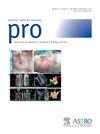Comparison of Pathologic Tumor Necrosis of Conventional Versus Ultrahypofractionated Preoperative Radiation Therapy in Localized Extremity Soft Tissue Sarcoma and Its Correlation With Clinical Outcomes
IF 3.4
3区 医学
Q2 ONCOLOGY
引用次数: 0
Abstract
Purpose
We aimed to determine if ultrahypofractionated radiation therapy (UHYPO-RT) delivering 6 Gy x 5 fractions yields similar tumor necrosis compared with conventional radiation therapy (CONV-RT) with 2 Gy x 25 fractions in soft tissue sarcoma. The clinical significance of tumor necrosis on loco-regional recurrence-free survival (LRFS), distant disease-free survival (DDFS), and overall survival (OS) were assessed.
Methods and Materials
Patients with localized soft tissue sarcoma treated with CONV-RT or UHYPO-RT followed by surgery were included. Good response was defined as tumor necrosis ≥90%, and poor response as <90%. The Mann-Whitney U test compared median tumor necrosis. χ2 analysis was used for categorical variables. The Kaplan-Meier function estimated LRFS, DDFS, and OS.
Results
A total of 64 patients received CONV-RT, and 45 received UHYPO-RT. The median tumor size was 7.0 cm, with the lower extremity being the most common site (55%). Myxofibrosarcoma (39%) and undifferentiated pleomorphic sarcoma (16%) were the most frequent histologies. The median time from radiation therapy to surgery was 35 days. There was a significant difference in median tumor necrosis between CONV-RT and UHYPO-RT, with rates of 40% and 60%, respectively (P = .022). Patients receiving UHYPO-RT had a higher percentage of tumor necrosis at the 90% cutoff, achieving 27% compared with 6% for CONV-RT (P = .003). At a median follow-up of 32 months, 12 patients (9%) experienced loco-regional recurrence, 24 patients (19%) faced distant failure, and 19 patients (15%) died of metastatic disease. Patients with <90% necrosis had higher rates of loco-regional (13% vs 0%, P = .207) and distant failure (25% vs 0%, P = .021). Three-year LRFS was 86% for <90% necrosis and 100% for ≥90% necrosis (P = .160). DDFS was 75% for <90% necrosis versus 100% for ≥90% (P = .036). OS rates were 79% and 93%, respectively (P = .290).
Conclusions
Preoperative RT with UHYPO-RT was associated with a higher rate of tumor necrosis ≥90% than CONV-RT. Our data suggest that more extensive necrosis is associated with better clinical outcomes.
一项关于局部四肢软组织肉瘤术前常规放疗与超高分次放疗的病理肿瘤坏死比较及其与临床疗效相关性的回顾性研究:一项关于局部四肢软组织肉瘤术前放疗CONV-RT与UHYPO-RT的病理肿瘤坏死比较及其与临床疗效相关性的回顾性研究。
背景和目的:我们旨在确定在软组织肉瘤(STS)中,6Gy x 5次分割的超高分次放射治疗(UHYPO-RT)与2Gy x 25次分割的常规放射治疗(CONV-RT)相比,是否能产生相似的肿瘤坏死。评估了肿瘤坏死对局部无区域复发生存率(LRFS)、远处无疾病生存率(DDFS)和总生存率(OS)的临床意义:纳入采用CONV-RT或UHYPO-RT治疗后再行手术的局部STS患者。肿瘤坏死≥90%为良好反应,<90%为不良反应。Mann-Whitney U检验比较了肿瘤坏死的中位数。对分类变量采用卡方分析。Kaplan-Meier函数估算了LRFS、DDFS和OS:共有64名患者接受了CONV-RT治疗,45名患者接受了UHYPO-RT治疗。肿瘤中位大小为7.0厘米,下肢是最常见的部位(55%)。肌纤维肉瘤(39%)和未分化多形性肉瘤(16%)是最常见的组织类型。从放疗到手术的中位时间为35天。CONV-RT和UHYPO-RT的中位肿瘤坏死率差异显著,分别为40%和60%(p = 0.022)。接受UHYPO-RT的患者在90%临界值的肿瘤坏死率更高,达到27%,而CONV-RT为6%(p = 0.003)。在中位 32 个月的随访中,12 名患者(9%)出现局部区域复发,24 名患者(19%)面临远处治疗失败,19 名患者(15%)死于转移性疾病。坏死率小于 90% 的患者的局部区域复发率(13% 对 0%,P = 0.207)和远处转移失败率(25% 对 0%,P = 0.021)较高。坏死率<90%的患者三年LRFS为86%,坏死率≥90%的患者三年LRFS为100%(P = 0.160)。坏死率< 90% 的 DDFS 为 75%,而坏死率≥ 90% 的 DDFS 为 100%(p = 0.036)。OS率分别为79%和93%(p = 0.290):结论:与CONV-RT相比,使用UHYPO-RT进行术前RT的肿瘤坏死率≥90%。我们的数据表明,更广泛的肿瘤坏死与更好的临床预后相关。
本文章由计算机程序翻译,如有差异,请以英文原文为准。
求助全文
约1分钟内获得全文
求助全文
来源期刊

Practical Radiation Oncology
Medicine-Radiology, Nuclear Medicine and Imaging
CiteScore
5.20
自引率
6.10%
发文量
177
审稿时长
34 days
期刊介绍:
The overarching mission of Practical Radiation Oncology is to improve the quality of radiation oncology practice. PRO''s purpose is to document the state of current practice, providing background for those in training and continuing education for practitioners, through discussion and illustration of new techniques, evaluation of current practices, and publication of case reports. PRO strives to provide its readers content that emphasizes knowledge "with a purpose." The content of PRO includes:
Original articles focusing on patient safety, quality measurement, or quality improvement initiatives
Original articles focusing on imaging, contouring, target delineation, simulation, treatment planning, immobilization, organ motion, and other practical issues
ASTRO guidelines, position papers, and consensus statements
Essays that highlight enriching personal experiences in caring for cancer patients and their families.
 求助内容:
求助内容: 应助结果提醒方式:
应助结果提醒方式:


